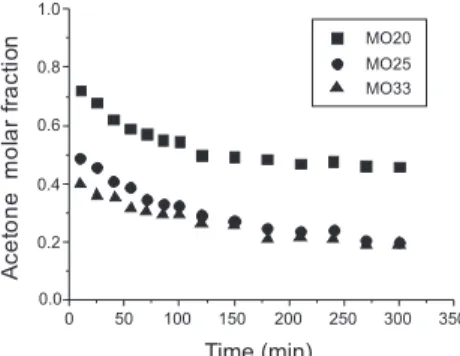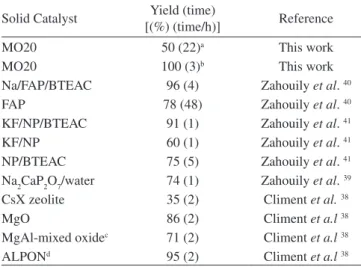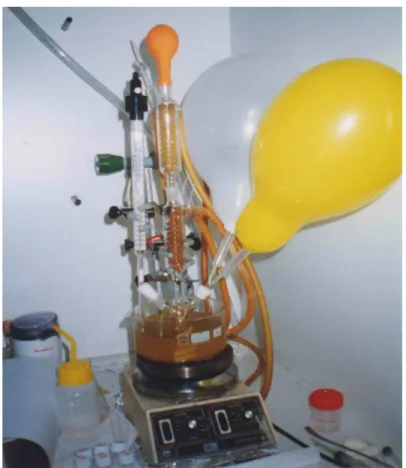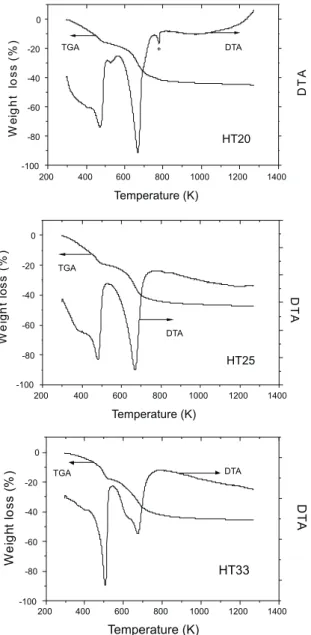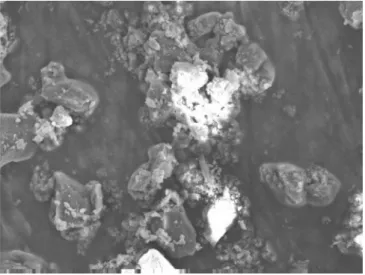Artigo
*e-mail: cah@uerj.br
INFLUENCE OF BASIC PROPERTIES OF Mg,Al-MIXED OXIDES ON THEIR CATALYTIC ACTIVITY IN KNOEVENAGEL CONDENSATION BETWEEN BENZALDEHYDE AND PHENYLSULFONYLACETONITRILE
Caridad Noda Pérez
Universidade Estadual de Goiás, BR 153 km 98, 75001-970 Anápolis – GO, Brasil José Luiz Fontes Monteiro
COPPE, Universidade Federal do Rio de Janeiro, CP 68502, 21941-972 Rio de Janeiro – RJ, Brasil Jose Manoel López Nieto
Instituto de Tecnología Química, Universidad Politécnica de Valencia, Avenida. los Naranjos s/n, 46022 Valencia, Espanha Cristiane Assumpção Henriques*
Instituto de Química, Universidade do Estado do Rio de Janeiro, Rua São Francisco Xavier, 524, 20550-900 Rio de Janeiro – RJ, Brasil
Recebido em 22/11/08; aceito em 9/5/09; publicado na web em 6/10/09
The catalytic performance of Mg,Al-mixed oxides (MO20, MO25 and MO33) derived from hydrotalcites was evaluated in the Knoevenagel reaction between benzaldehyde and phenylsulfonylacetonitrile at 373 and 383 K. The best results were obtained for the sample MO20 that presented the highest basic sites density and external area and the smallest crystallite sizes. The relative amount of basic sites with weak to intermediate strength also played an important role on catalytic performance. By increasing the catalyst content from 1 to 5 wt.% at 383 K, a complete conversion of the reactants is attained, producing α-phenylsulfonylcinnamonitrile with a selectivity of 100%.
Keywords: Knoevenagel condensation; Mg,Al-mixed oxides; α-phenylsulfonylcinnamonitrile.
INTRODUCTION
The interest for the development of environmentally friendly solid catalysts has increased in recent years aiming at the replacement of soluble acids (H2SO4, HF) and bases (alkali metal hydroxides or alkoxides) currently used as catalysts in the synthesis of ine chemicals and pharmaceuticals. The use of heterogeneous catalysts not only allow easy separation and recycle of the catalyst from the reaction mixture, but also reduces the generation of toxic wastes that consist primarily of inorganic salts formed in the reaction or in subsequent neutralization steps. Moreover, the acid or basic sites density and their strength as well as other physico-chemical characteristics of these catalysts can be tailored for the process of interest by adequate preparation procedures and/or by post-synthesis treatments.
As to basic catalysts, Mg,Al-mixed oxides derived from hydro-talcites are among the solids that have replaced homogeneous ca-talysts with considerable success. Hydrotalcites are layered double magnesium-aluminum hydroxides (LDH) with general formula [Mg8-xAlx(OH)16(CO32-)
x/2].nH2O, whose structure consists of
brucite-like layers, where partial substitution of Al3+ for Mg2+ cations
origina-tes an excess of positive charges which are compensated by carbonate anions located along with water molecules in the interlayer space.1,2
The Al/(Al+Mg) ratio in hydrotalcites can take values between 0.20 and 0.34.2 Thermally treating hydrotalcites induces dehydration,
dehydroxylation, and loss of compensation anions, forming the Mg-Al-mixed oxides with basic properties, large speciic surface area and a poorly crystallized MgO-type structure.1,3-5 So, they are
potentially useful as adsorbents and as heterogeneous base catalysts and catalytic supports. The catalytic applications of Mg,Al-mixed oxides obtained from hydrotalcites include base-catalyzed reactions such as aldol condensation of aldehydes and ketones and condensa-tion of the carbonyl group with compounds presenting methylene activated groups (for example, Knoevenagel and Claisen-Schmidt
reactions),1,6-20 Michael additions,21 alkene isomerization,22 alkylation
of di-ketones and phenols,23,24 and alkene epoxidation activated by
hydrogen peroxide.25
The sulfones present considerable applications as intermediates in organic synthesis,26-29 since arylsulfonyl groups can stabilize adjacent
carbanions30 and may easily be removed by hydrolysis, reduction or
elimination31 and, when appropriate, may be eliminated to introduce
carbon-carbon double bonds into organic molecules.32 So, they are
useful temporary activating groups for various reactions.
The base-catalyzed Knoevenagel condensation of arylsulfones and aldehydes is the most convenient method for synthesizing unsaturated arylsulfones.33 The irst step of the reaction is the abstraction of a proton
from the phenylsulfonylalkane molecule usually catalyzed by strong bases such as butyllithium,34 lithium diisopropylamide35 or sodium
hydride.36 However, the deprotonation depends on the presence of
adjacent electron-withdrawing groups such as ester, nitrile or ketone.33
The recent concern about the environment is increasing the interest in the development of clean and economic process for the production of ine chemicals. In this context, solid base catalysts have received incre-asing attention as substitutes for the highly pollutant liquid catalysts in organic reactions. This replacement has several technical advantages, such as little or no corrosion, easy handling and separation, catalysts reutilization, and reduction of the amount of toxic wastes.
Thus, the Mg,Al-mixed oxides derived from hydrotalcites, which combine small particle size, large speciic surface area, and basic sites with different strength associated to hydroxyl groups, O2- - Mn+
acid-base pairs and O2- anions,6-8,37 seems to be appropriate catalyst for the
Knoevenagel condensation of arylsulfones and aldehydes. Another interesting feature of these materials is the possibility of tailor their basic properties (density and strength distribution of basic sites) for the process under study, by adjusting their chemical composition (Al/ (Al+Mg) molar ratio) and/or the method of preparation of the parent hydrotalcite.7,22,23,37,38
α-phenyl-sulfonylcinnamonitrile, at 373 K, was irst reported by Climent et al..33 The parent hydrotalcites were synthesized at pH = 13 and aged
at 473 K for 18 h. They found that the corresponding mixed oxides showed a maximum activity for an Al/(Al + Mg) molar ratio of 0.20. However, they were slightly less active than an ALPON catalysts with 13.9 wt.% of N under similar experimental conditions.33 The
synthesis of unsaturated arylsulfones over solid catalysts such as Na2CaP2O7, doped natural phosphate (KF/NP) and Na/luoroapatite (luoroapatite doped with NaNO3) was also studied by Zahouily et al.39-41 under mild conditions in the presence of solvent (methanol
or ethanol). Results as good as those reported by Climent et al.33 were obtained for KF/NP and Na/luoroapatite when activated by benziltriethylammonioumchloride (BTEAC).
The present work was developed aiming at to evaluate the role played by the basic and the textural properties of the Mg,Al-mixed oxides obtained by thermal treatment of hydrotalcites with different Al/(Al+Mg) molar ratios on their catalytic performance in Knoeve-nagel condensation between benzaldehyde and phenylsulfonylace-tonitrile producing α-phenylsulfonylcinnamonitrile without solvent.
EXPERIMENTAL
Hydrotalcite synthesis and activation
The hydrotalcites used as catalyst precursors were prepared by coprecipitation at room temperature, as previously described by Noda Pérez et al..9 The synthesis gels were produced by slowly dropping (60 mL h-1) solution A (100 mL), containing Mg(NO
3)2.6H2O and
Al(NO3)3.9H2O ([Al+Mg] = 1.5 M and Al/(Al+Mg) molar ratios equal to 0.20, 0.25 or 0.33) into solution B (100 mL), prepared by dissolving appropriate amounts of Na2CO3 and NaOH in distilled water in order to obtain [CO32−] equal to 1.0 mol/L and a constant pH during the
aging of the gel, under vigorous stirring. The gels were aged under pH (10) at 333 K for 18 h and the solids obtained were iltered and washed with hot distilled water (363 K) until pH 7. Then they were dried at 353 K overnight. The hydrotalcites prepared were named as HTXX, where XX is the Al/(Al+Mg) nominal molar ratio (in %).
To obtain the Mg,Al-mixed oxides the samples were calcined under dry air from room temperature up to 723 K at 1 K min-1, and
kept at this temperature for 10 h immediately before each run. The mixed oxides so obtained were named as MOXX, where XX is the same as that of the parent hydrotalcite.
Physico-chemical characterization
The chemical composition of the as-synthesized hydrotalcite samples was determined by atomic absorption spectrometry (AAS) using a Perkin-Elmer AAS 1100B spectrometer. X-ray diffraction patterns (XRD) were recorded in a Rigaku X-Ray Diffractometer equipped with a graphite monochromator using CuKα radiation, 40 kV and 40 mA. The software Materials Data Jude, Version 5.0, was employed for structural reinement aiming at calculating the cell parameters. Thermal decomposition of hydrotalcites, evaluated by thermogravimetric analysis (TGA) and derivative thermoanalysis (DTA), was carried out in a Rigaku Thermobalance TAS100 operating under a low of air at a 10 K min-1 heating rate up to 1273 K.
The textural characteristics of the Mg,Al-mixed oxides, such as BET speciic area, external area (t-plot method) and pore volume (BJH method), were determined by N2 adsorption-desorption at 77 K in a Micromeritics ASAP 2000. Prior to the analyses, the samples were outgassed for 3 h at 723 K. The morphology and the size of the particles of the mixed oxides were obtained by scanning electron microscopy (SEM) in a JEOL-JSM 5800 microscope operating at an
accelerating voltage of 20 kV. Before the analysis, the samples were mounted in a stub and were sputter-coated with a ine layer of gold.
The relative basicity of the Mg,Al-mixed oxides was evaluated by means of the diacetone alcohol (DAA) retroaldolization model reaction that forms acetone as the only product via basic catalysis (Figure 1S, supplementary material).9 It was studied in a ixed-bed
microreactor at 1 atm, 313 K and WHSV (gram of DAA per hour per gram of catalyst) equal to 19.3 h-1. The reactant was fed to the reactor
by bubbling nitrogen (170 mL min-1) through a saturator containing
DAA held at 303 K. Before the reaction, the original hydrotalcite was calcined in situ under dry air at 723 K for 10 h (heating rate of 10 1 K min-1). Then, the system was cooled down to 313 K and the
reaction started. The exit stream was regularly analyzed by on-line gas chromatography (50 m CP-Sil 5CB column on a Chrompack 9000 gas chromatograph).
The density and the strength distribution of the basic sites of the calcined hydrotalcites were determined by temperature-programmed desorption (TPD) of CO2. The samples were produced in situ by tre-ating the hydrotalcite precursors as described above. Pure CO2 was adsorbed at room temperature and the sample was lushed with He to eliminate physically adsorbed molecules. TPD analyses were run under He at a heating rate of 20 K min-1 up to 723 K. The amount
of CO2 chemisorbed and its desorption proile were measured on a Micromeritics 2900 TPR/TPD analyzer with a quadrupole mass spectrometer detector (Balzers QMS-200).
Reaction procedure
The reaction was carried out in liquid phase without solvent under inert atmosphere (N2) in a 10 mL three-necked round bottom glass lask immersed in a thermostated silicone oil bath and equipped with a relux condenser connected to the central neck (Figure 2S, supple-mentary material). After purging the system with N2, benzaldehyde (8 mmoles) and phenylsulfonylacetonitrile (8 mmoles) were introduced in the reactor and the system was heated to the desired temperature (373 or 383 K) under magnetic stirring. Next, the catalyst (obtained by calcination ex-situ under the conditions previously described) was rapidly transferred to the reactor containing the mixture of the reactants and the reaction started. The concentration of catalyst was 1 or 5 wt.% with respect to the weight of reactants. Samples were periodically taken by means of a iltering syringe, dissolved in acetone and analyzed by gas chromatography using a 30 m Supelco 2/400, 34, SPB/5 capillary column in a Varian 3300 gas chromatograph (FID). Quantitative determinations were based on the calculated response factors for binary mixtures of the reactants and reaction product. The maximum reaction time explored was 22 h.
RESULTS AND DISCUSSION
Physico-chemical characterization
The results of chemical analysis of the hydrotalcite samples, expressed by their Al/(Al+Mg) molar ratios, are shown in Table 1. It can be observed that, for the sample with the largest Al content, the Al/(Al + Mg) molar ratio was slightly lower than that of the corres-ponding synthesis gel, indicating that the incorporation of Al from the gel was slightly smaller than that of Mg. Similar trend was also observed by other authors.42,43
planes (003), (006), (110) and (113)) and are also shown in Table 1. The values of parameter a, which is a function of the cation-cation distance in the hydroxide layers, were in the range 3.14-3.04 Å and they decreased with increasing Al/(Al+Mg) molar ratio due to the progressive isomorphic replacement of Mg2+ (ionic radii of 0.65 Å)
by Al3+ (ionic radii of 0.50 Å). Parameter c, which is related to the
layer thickness (brucite-like sheet plus an interlayer), is inluenced both by the size of the interlayer anion and the M2+-M3+ cations. It
also decreased with the increase in the Al content.2
The TGA/DTA results for the as-synthesized samples are compa-ratively reported in Table 1. They show that the maximum temperature of the peaks in the DTA proiles slightly increases with increasing aluminum content. Two well-deined weight losses were observed in the proiles (Figure 4S, supplementary material), which are in good agreement with those reported in the literature for hydrotalcites in carbonate form.1,3,4 The irst step, up to 500 K, corresponds to the loss
of interlayer water, while the second step, between 548 and 723 K, is associated to dehydroxylation and decarbonation.
From the chemical analysis (Al/(Al+Mg) molar ratio) and the TGA results (weight loss associated to interlayer water) the chemical formula of the hydrotalcite samples were calculated and are also presented in Table 1.
Upon calcination at 723 K the layered structure of hydrotalcites collapsed, forming the Mg,Al-mixed oxides with a poorly crystallized MgO periclase-type structure whose unit cell parameter decreases as the (Al/(Al+Mg)) molar ratio increases. Inspection of the corresponding N2 adsorption/desorption isotherms indicated that all samples presen-ted IUPAC type IV isotherms (Figure 5S, supplementary material), conirming that the thermal decomposition of the hydrotalcite samples produced mesoporous Mg,Al-mixed oxides (Figure 6S, supplementary material). Their main textural characteristics are shown in Table 2 and they indicate that the BET areas decrease with increasing Al content and the mesoporous (diameter up to 60 nm) volume, calculated by the BJH method using the adsorption branch, present a minimum value (close to 0.40 cm3/g) for the sample with an Al/(Al+Mg) ratio equal
to 0.25. Microporous volumes are not very signiicant, although they contribute in an important way to the BET area, and the external area actually relects the contribution of the mesoporous system.
The scanning electron micrographs of the mixed oxides indicated that they are formed by particles with irregular surface and without a well-deined shape, as shown in Figure 1, for samples MO20 and
MO25, and in Figure 7S - supplementary material, for sample MO33. It can be observed that the Al content inluenced the size and the morphology of the particles. Thus, the sample with the lowest Al content (MO20) was formed by aggregates of small particles with size in the range 4-10 µm while sample MO25 was formed by big particles in the range 400-700 µm and sample MO33 by particles of about 70 µm and aggregates of small particles with size of 5-10 µm.
Basicity characterization
Figure 2 shows the molar fraction of acetone formed during the retroaldolization of diacetone alcohol catalyzed by the Mg,Al-mixed oxides. It can be observed that the initial activity of the samples (given by the acetone molar fraction) decreased with the increasing Al content up to Al/(Al+Mg) molar ratio equal to 0.25. For samples MO25 and MO33 the behavior was similar. This seems to support previous observations of other authors1,44 that, although the basic sites
density decreases with increasing Al content, the relative proportion of strongly basic sites increases. Although this possibility can not be discarded, one would expect it to hold for demanding reactions and this is not the case of the diacetone alcohol retroaldolization reaction, which can be easily performed even at room temperature.
On the other hand, Figure 3 indicates that a good correlation is ob-served between acetone initial molar fraction and external area for all the mixed oxide samples. This suggests that for a facile reaction such as the Figure 1. SEM micrographs of Mg,Al-mixed oxide derived from: (a) HT20 (magniication 450X, photo width 293 µm); (b) HT25 (magniication 70X, photo width 1.89 mm)
Table 1. Chemical analysis, cell parameters and thermogravimetric analysis of synthesized hydrotalcites
Sample Al/(Al+Mg) a (Å) c (Å) Loss of interlayer water decarbonationDehydration /
Chemical formula
gela sampleb (wt.%) T (K) (wt.%) T (K)
HT20 0.20 0.20 3.063 ± 0.0004 23.49 ± 0.021 18.2 477 26.6 670 Mg6.4Al1.6(CO3)0.8(OH)16.6.4 H2O
HT25 0.25 0.25 3.060 ± 0.0023 23.32 ± 0.102 18.8 476 24.6 671 Mg6Al2(CO3)(OH)16.6.8 H2O
HT33 0.33 0.31 3.047 ± 0.006 22.91 ± 0.064 18.7 494 24.5 676 Mg5.5Al2.5(CO3)1.25(OH)16.7.0 H2O
a: Nominal value. b: Experimental value
Table 2. Textural and morphological characteristics of calcined hydrotalcites
Sample SBET
(m2/g)
SEXT (m2/g)a
Vmicro (cm3/g)a
Vmeso (cm3/g)b
MO20 271 179 0.041 0.47
MO25 242 131 0.048 0.37
MO33 179 118 0.027 0.54
present one accessibility of the reactant to the active sites on the surface of the mesopores and on the external surface of the particles (as expressed by Sext) is the governing parameter rather than the strength of the sites or their theoretical global concentration (related to the Al content).
The thermograms corresponding to CO2 temperature-program-med desorption are shown in Figure 4. They were deconvoluted into three desorption peaks with maxima in the ranges 390-411, 430-461, and 510-550 K. Deconvoluting into three peaks gave the best it and agrees with previous results of Di Cosimo et al.36 that associated their results to those obtained from the infrared spectra of adsorbed CO2 and related the L.T.P. (low-strength basic sites) to surface hydroxyl groups and the M.T.P. (medium-strength basic sites) and H.T.P. (high-strength basic sites) to surface basic oxygen atoms.
The basic sites density, shown in Table 3, followed the order MO20 > MO25 ≈ MO33, which is similar to that observed for the activity of the samples for DAA retroaldolization. Table 3 also shows the relati-ve contribution of each individual desorption peak calculated by the integration of its proile. It can be observed that for the Mg,Al-mixed oxides the high strength basic sites are predominant, as previously re-ported by Veloso et al.,20 and the relative amount of sites with different
strengths is inluenced by the Al content. These results did not support the suggestion1,44 that the increase in Al content decreases the basic
sites density but increases the relative proportion of strong basic sites.
Catalytic tests
The scheme of the base-catalyzed Knoevenagel condensation be-tween phenylsulfonylacetonitrile (1) and benzaldehyde (2) producing α-phenylsulfonylcinnamonitrile (4) is represented in Figure 5. The mechanism generally accepted for the reaction involves, in the irst step, the abstraction of a proton from phenylsulfonylacetonitrile (1) by a basic site with the formation of the corresponding carbanion (1´). This carbanion (1´) attacks the carbonyl group of the benzaldehyde (2), giving
the alcohol intermediate (3). In the last step, water is removed and a C = C bond is formed. Finally, the active site of the basic catalyst is restored.
The comparison of the catalytic performance of the different mi-xed oxides was initially carried out at 373 K, using 1 wt.% of catalyst. The effect of reaction time on conversion of phenylsulfonylacetonitri-le is presented in Figure 6. It can be observed that Mg,Al-mixed oxides are active in catalyzing the desired reaction, the highest activity being presented by the catalyst with the lowest aluminum content (MO20), Table 3. Results of temperature-programmed desorption of CO2 for the studied samples
Catalyst
Basic site densities (µmol de CO2/g)
Desorption peaks (area %) L.T.P.a
390-411 K
M.T.P.b
430-461 K
H.T.P.c
510-550 K
MO20 502 18 35 47
MO25 412 16 23 61
MO33 410 17 28 55
a L. T. P. = low temperature peak; b M.T.P. = medium (intermediate) temperature peak; c H.T.P. = high temperature peak
Figure 5. Mechanism of Knoevenagel condensation between benzaldehyde and phenylsulfonylacetonitrile
Figure 4. Proiles of temperature programmed desorption of CO2 Figure 2. Acetone formation from retroaldolization of DAA (atmospheric
pressure, 313 K, WHSV = 19.3 h-1)
as also observed by Climent et al.33α-phenylsulfonylacetonitrile conversion decreased with increasing Al/(Al+Mg) ratios, passing through a minimum for Al/(Al+Mg) equal to 0.25, and then slightly increasing. This behavior is different from that reported by Climent et al.33 who observed a decreasing activity when the Al/(Al+Mg) ratio was increased above 0.20. For all the studied catalysts, the selectivity to α-phenylsulfonylcinnamonitrile was 100%.
For the studied samples, increasing the Al content from Al/(Al + Mg) = 0.20 to 0.25 decreases both the relative basicity (measured by DAA retroaldolization) and the basic sites density (TPD of CO2). Further increase in Al content to 0.33 did not change these basic cha-racteristics signiicantly. Thus, relative basicity and basic sites density explain the best performance of catalyst MO20 for the Knoevenagel condensation between phenylsulfonylacetonitrile and benzaldehyde. Besides these basic characteristics, the textural properties (external and BET speciic areas) could also justify the highest activity of sample MO20. However, to explain the order of catalytic activity observed: MO20 >> MO33 > MO25, it is important to consider also the relative amount of sites with different basic strength.
For the reaction under study, basic sites with weak to intermediate strength should be able to perform the reaction since in the phenylsul-fonylacetonitrile molecule the methylenic group is strongly activated by the cyano and phenylsulfonyl groups, making it relatively easy for the catalyst to generate the carbanium by extracting the proton. Indeed, this is the case of the catalytic activity (given by phenylsul-fonylacetonitrile conversion) presented in Figure 6 that follow the same trend of the relative amount of weak plus intermediate strength basic sites of the samples (Table 3).
It is important to notice that the particle size could also play an important role since the reaction involves voluminous molecules and the existence of diffusion limitations associated to large parti-cles should affect the catalytic performance, since they can restrict the access of the reactant to the active sites inside the pores. This suggestion is supported by the fact that the catalytic activity of the samples: MO20 >> MO33 > MO25 followed an order inverse as to their crystallite sizes (MO20 < MO33 < MO25).
The role of basic, textural and morphological properties was also observed when the studied samples (MO20, MO25 and MO33) were evaluated as catalysts on the aldol condensation of citral and acetone forming pseudoionones.9 The results were summarized in Table 4,
which shows that the highest activity was presented by the catalyst with the lower aluminum content (MO20). Citral conversion decre-ased with the increase in Al/(Al+Mg) ratio up to 0.25 and incredecre-ased for the sample with the highest Al content. Again, relative basicity, basic sites density and textural characteristics explain the best catalytic
performance of MO20 whereas the relative distribution of basic sites with different strength must be considered to justify the order of catalytic activity (MO20 > MO33 > MO25). Since this reaction also involves voluminous molecules, diffusion limitations associated the differences on crystallite size can also be taken into account.
By increasing the reaction temperature to 383 K and the catalyst concentration to 5 wt.% a near complete conversion of phenylsulfonyla-cetonitrile is reached after only 45 min of reaction with 100% selectivity to the desired product (Figure 8S, supplementary material). Table 5 shows the results obtained in the present work with MO20 as catalyst along with those reported in the literature for the same reaction over other catalysts. Although the reaction yields cannot be directly com-pared since the reactions were carried out under different experimental conditions (temperature, catalyst concentration and presence/absence of solvent), it can be observed that our best result is equivalent to the best ones reported over other solid catalysts. Thus, this conirms the Mg,Al-mixed oxides derived from hydrotalcites as potential catalysts for clean processes involving Knoevenagel condensation and other base-catalyzed reactions with interest in ine chemistry.
CONCLUSIONS
The chemical composition of the parent hydrotalcites matched that of the synthesis gels. Their lattice parameters, calculated from the X-ray diffractograms, decreased with the increase in the Al/(Al+Mg) molar ratio due the partial replacement of Mg2+ cations by the smaller
Al3+ cations. As expected, the TGA/DTA proiles showed two
well-deined weight losses and the increase in the aluminum content shifted the peaks in DTA proiles for slightly higher temperatures.
Textural characterization of the Mg,Al-mixed oxides showed that the BET area decreased with increasing aluminum content, that mesoporous volumes were minima for samples with Al/(Al+Mg) ratio equal to 0.25, that microporous volumes were not very signiicant, and that the external areas relect the contribution of the mesoporous.
The scanning electron micrographs of the mixed oxides indicated that they are formed by aggregates of particles with irregular surface and without a well-deined shape whose sizes were inluenced by their chemical composition.
The relative basicity of the mixed oxides, determined by retro-aldolization of diacetone alcohol, decreased with the increase in Al content up to Al/(Al+Mg) molar ratio equal to 0.25. Further increase in the Al content did not inluence this basic property. On the other hand, a good correlation was observed between the relative basicity and external area, suggesting that for this model reaction accessibility of the reactant to the active sites is the governing parameter rather than the strength of the sites or their theoretical global concentration (related to the Al content). The basic sites density determined by TPD of CO2 followed the same order of the relative basicity (MO20 > MO25 ≈ MO33). It was also observed that the high strength basic sites are predominant and that the relative amount of sites with di-fferent strengths is inluenced by the Al content.
The Mg,Al-mixed oxides derived from hydrotalcites were efi-cient catalysts for the Knoevenagel reaction between benzaldehyde Table 4. Citral conversion as a function of Al/(Al+Mg) molar ratio (398 K, autogenous pressure, acetone/citral = 1 (molar), 5% of catalyst)
Catalyst Citral conversion (%)
MO20 56.0
MO25 32.4
MO33 43.5
and phenylsulfonylacetonitrile producing α-phenylsulfonylcinnamo-nitrile with 100% selectivity at 373 K. The best catalytic performance was presented by the Mg,Al-mixed oxide with the lowest aluminum content (Al/(Al+Mg) = 0.20), that had the highest basic sites density and external area and the smallest particle size. It was proposed that the studied reaction is catalyzed by basic sites with weak to inter-mediate strength. So, the relative amount of these sites played an important role on catalytic performance.
Since the studied reaction involves voluminous reactants and the catalytic activity also followed an inverse trend as to the particle sizes, the effect of this parameter on the accessibility of the voluminous mo-lecules and consequently on catalytic activity cannot be disregarded.
SUPPLEMENTARY MATERIAL
Figures identiied as S along the manuscript can be freely accessed as supplementary material (pdf ile) in http://quimicanova.sbq.org.br.
ACKNOWLEDGEMENTS
The authors would like to thank CYTED – Programa Iberoame-ricano de Ciencia y Tecnología para el Desarrollo (Project V.5), FA-PERJ – Fundação de Amparo à Pesquisa do Estado do Rio de Janeiro, and UERJ (PROCIENCIA Program) for the inancial support. The cooperation of Prof. A. Corma, director of the Instituto de Tecnologia Química (UPV-CSIC, Valencia, Spain), where the experiments were performed, is also acknowledged.
REFERENCES
1. Tichit, D.; Lhouty, M. H.; Alain, G.; Chiche, B. H.; Figueras, F.; Auroux, A.; Bartalini, D.; Garrone, E.; J. Catal. 1995, 151, 50.
2. Cavani, F.; Trifirò, F.; Vaccari; A.; Catal. Today 1991, 11, 173. 3. McKenzie, A. L.; Fishel, C. T.; Davis, R. J.; J. Catal. 1992, 138, 547. 4. Rey, F.; Fornés, V.; Rojo, J. M.; J. Chem. Soc. Faraday Trans. 1992, 88,
2233.
5. Del Arco, M.; Martin, C.; Martin, I.; Rives, V.; Trujillano, R.; Spectrochim. Acta 1993, 49A, 1575.
6. Corma, A.; Iborra, S.; Primo, J.; Rey, F.; Appl. Catal., A 1994, 114, 215. 7. Climent, M. J.; Corma, A.; Iborra, S.; Primo J.; J. Catal. 1995, 151, 60.
8. Climent, M.J.; Corma, A.; Iborra, S.; Epping, K.; Velty, A.; J. Catal. 2004, 225, 316.
9. Noda Pérez, C.; Pérez, C. A.; Henriques, C. A.; Monteiro, J. L. F.; Appl. Catal., A 2004, 272, 229.
10. Suzuki, E.; Ono, Y.; Bull. Chem. Soc. Jpn. 1988, 61, 1008. 11. Corma, A.; Martin-Aranda, R. M.; Appl. Catal., A 1993, 105, 271. 12. Guida, A.; Lhouty, M. H.; Tichit, D.; Figueras, F.; Geneste, P.; Appl.
Catal., A 1997, 164, 251.
13. Rao, K. K.; Gravelle, M.; Valente, J. S.; Figueras, F.; J. Catal. 1998, 173, 115.
14. Noda Pérez, C.; Alt, G. P.; Werneck, R. M.; Henriques C. A.; Monteiro, J. L. F.; Brazil. J. Chem. Eng. 1998, 15, 120.
15. Roelofs, J. C. A. A.; van Dillen, J. A.; de Jong, P. K.; Catal. Today 2000, 60, 297.
16. Roelofs, J. C. A. A.; van Dillen, J. A.; de Jong, P. K.; Catal. Lett. 2001, 74, 91.
17. Veloso, C. O.; Henriques, C. A.; Dias, A. G.; Monteiro, J. L. F.; Catal. Today 2005, 107-108, 294.
18. Angelescu, E.; Pavel, O. D.; Bîrjega, R.; Zavoianu, R.; Constentin, G.; Che, M.; Appl. Catal., A 2006, 308, 13.
19. Abello, S.; Vijaya-Shankar, D.; Pérez-Ramírez, J.; Appl. Catal., A 2008, 342, 119.
20. Veloso, C. O.; Noda Pérez, C.; Souza, B. M.; Lima, E. C.; Dias, A. G.; Monteiro, J. L. F.; Henriques, C. A.; Microporous Mesoporous Mater. 2008, 107, 23.
21. Choudary, B. M.; Lantam, M. L.; Reddy, C. R. V.; Rao, K. K.; Figueras, F.; J. Mol. Catal. A: Chem. 1999,146, 279.
22. Sharper, H.; Berg-Slot, J. J.; Stork, W. H. J.; Appl. Catal. 1989, 54, 79. 23. Velu, S.; Swamy, C. S.; Appl. Catal., A 1994, 119, 241.
24. Cativela, C.; Figueras, F.; Garcia, J. J.; Mayoral, J. M.; Zumbano, M. M.; Synth. Commun. 1995, 25, 1745.
25. Cativela, C.; Figueras, F.; Fraille, J. M.; Garcia, J. J.; Mayoral, J. M.; Tetrahedron Lett. 1995, 36, 4125.
26. Magnus, P. D.; Tetrahedron 1977, 33, 2019. 27. Trost, B. M.; Bull. Chem. Soc. Jpn. 1988, 61, 107.
28. Orita, A.; Yoshioka, N.; Oteru, J.; Chem. Lett. 1997, 26, 1023. 29. Rayner, C. M.; Contemp. Org. Synth. 1995, 2, 409.
30. Zhang, Z.; Liu, G. J.; Wang, Y. L.; Wang, W.; Synth. Commun. 1989, 19, 1167.
31. Trost, B. M.; Schmuff, N. R.; Miller, M. J.; J. Am. Chem. Soc. 1980, 102, 5979.
32. Orr, D.; Synthesis 1979, 139.
33. Climent, M. J.; Corma, A.; Guil-Lopez, R.; Iborra, S.; Primo, J.; Catal. Lett. 1999, 59, 33.
34. Kondo, K.; Tunemoto, D.; Tetrahedron Lett. 1975, 1007.
35. Olson, G. L.; Cheung, H. O.; Morgan, K. D.; Neukom, C.; Saucy, G.; J. Org. Chem. 1976, 41, 3287.
36. Trost, B.; Verhoeven, T. R.; J. Am. Chem. Soc. 1978, 100, 3435. 37. Di Cosimo, J. I.; Díez, V. K.; Xu, M.; Iglesias, E.; Apestegía, C. R.; J.
Catal. 1998, 178, 499.
38. Corma, A.; Fornés, V.; Rey, F.; J. Catal. 1994, 148, 205.
39. Zahouily, M.; Salah, M.; Bennazha, J.; Rayadh, A.; Sebti, S.; Tetrahe-dron Lett. 2003, 44, 3255.
40. Zahouily, M.; Salah, M.; Bahlaouan, B.; Mounir, B.; Rayadh, A.; Sebti, S.; Catal. Lett. 2004, 96, 57.
41. Zahouily, M.; Salah, M.; Bahlaouane, B.; Rayadh, A.; Houmam, A.; Hamed, E. A.; Sebti, S.; Tetrahedron 2004, 60, 1631.
42. Roelofs, J. C. A. A.; Lensveld, D. J.; van Dillen, J. A.; de Jong, P. K; J. Catal. 2001, 202, 184.
43. Vucelic, M; Moggridge, C. D.; Jones, W.; J. Phys. Chem. 1995, 99, 8328.
44. Nakatsuka, T.; Kawasaki, H.; Yamashita, S.; Kohijiya, S.; Bull. Chem. Soc. Jpn. 1979, 52, 2449.
Table 5. Knoevenagel condensation between benzaldehyde and phenylsulfonylacetonitrile. α-phenylsulfonylcinnamonitrile yields over different solid catalysts
Solid Catalyst [(%) (time/h)]Yield (time) Reference
MO20 50 (22)a This work
MO20 100 (3)b This work
Na/FAP/BTEAC 96 (4) Zahouily et al. 40
FAP 78 (48) Zahouily et al. 40
KF/NP/BTEAC 91 (1) Zahouily et al. 41
KF/NP 60 (1) Zahouily et al. 41
NP/BTEAC 75 (5) Zahouily et al. 41
Na2CaP2O7/water 74 (1) Zahouily et al. 39
CsX zeolite 35 (2) Climent et al. 38
MgO 86 (2) Climent et a.l 38
MgAl-mixed oxidec 71 (2) Climent et a.l 38
ALPONd 95 (2) Climent et a.l 38
Material Suplementar
*e-mail: cah@uerj.br
INFLUENCE OF BASIC PROPERTIES OF Mg,Al-MIXED OXIDES ON THEIR CATALYTIC ACTIVITY IN KNOEVENAGEL CONDENSATION BETWEEN BENZALDEHYDE AND PHENYLSULFONYLACETONITRILE
Caridad Noda Pérez
Universidade Estadual de Goiás, BR 153 km 98, 75001-970 Anápolis – GO, Brasil
José Luiz Fontes Monteiro
COPPE, Universidade Federal do Rio de Janeiro, CP 68502, 21941-972 Rio de Janeiro – RJ, Brasil
Jose Manoel López Nieto
Instituto de Tecnología Química, Universidad Politécnica de Valencia, Avenida. los Naranjos s/n, 46022 Valencia, Espanha
Cristiane Assumpção Henriques*
Instituto de Química, Universidade do Estado do Rio de Janeiro, Rua São Francisco Xavier, 524, 20550-900 Rio de Janeiro – RJ, Brasil
Figure 1S. Reaction scheme of diacetone alcohol retroaldolization
Figure 3S. X-ray diffractograms for the as-synthesized hydrotalcite samples. Peaks marked with (*) correspond to hydromagnesite
Figure 4S. DTA-TGA proiles for samples HT20, HT25 and HT33
Figure 5S. N2 physisorption isotherms for samples MO20, MO25 and MO33
Figure 6S. Pore size distribution for samples MO20, MO25 and MO33 (BJH
Figure 7S. SEM micrographs of Mg,Al-mixed oxide derived from HT33 (magniication 230X, photo width 574 µm)

